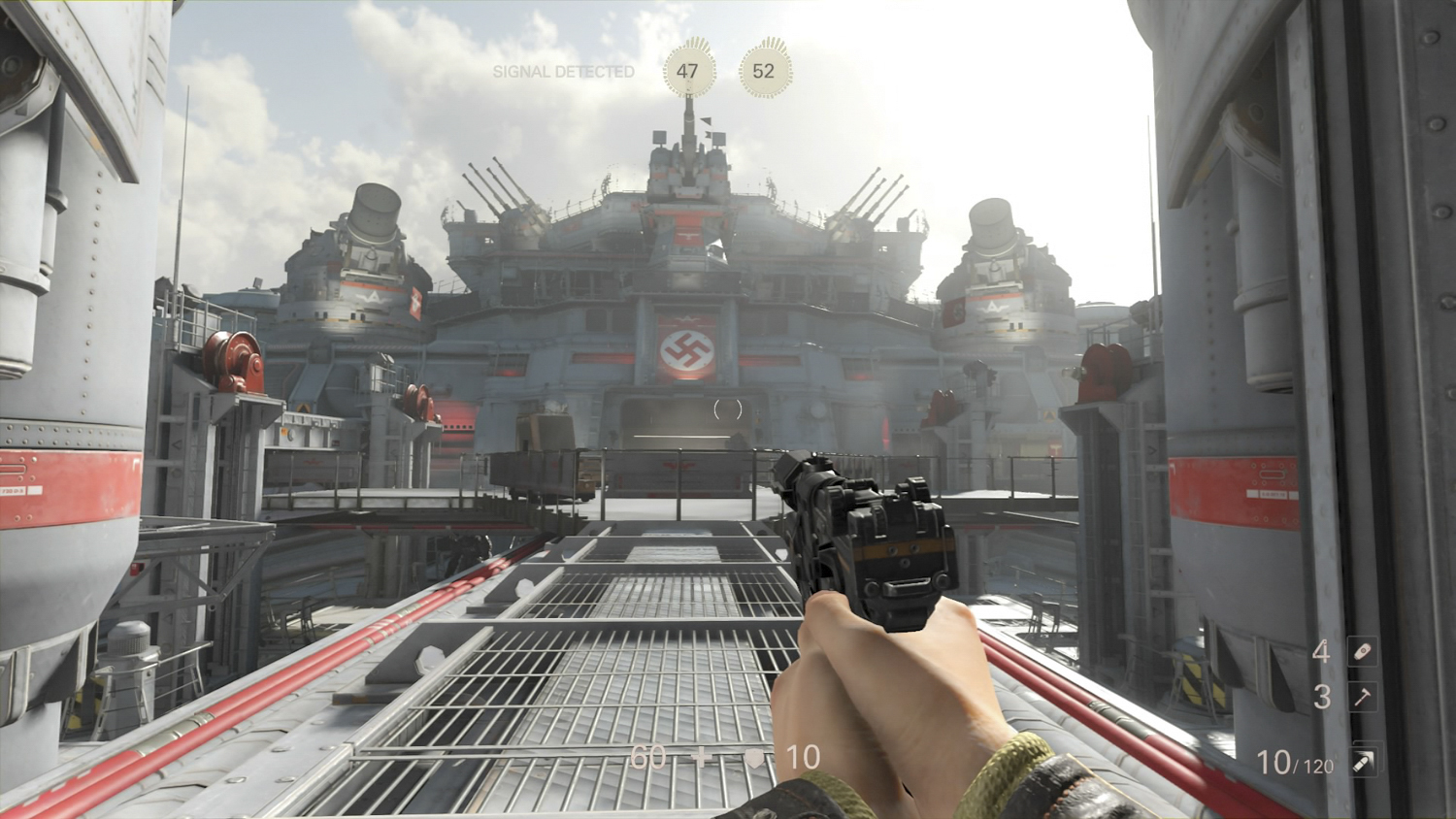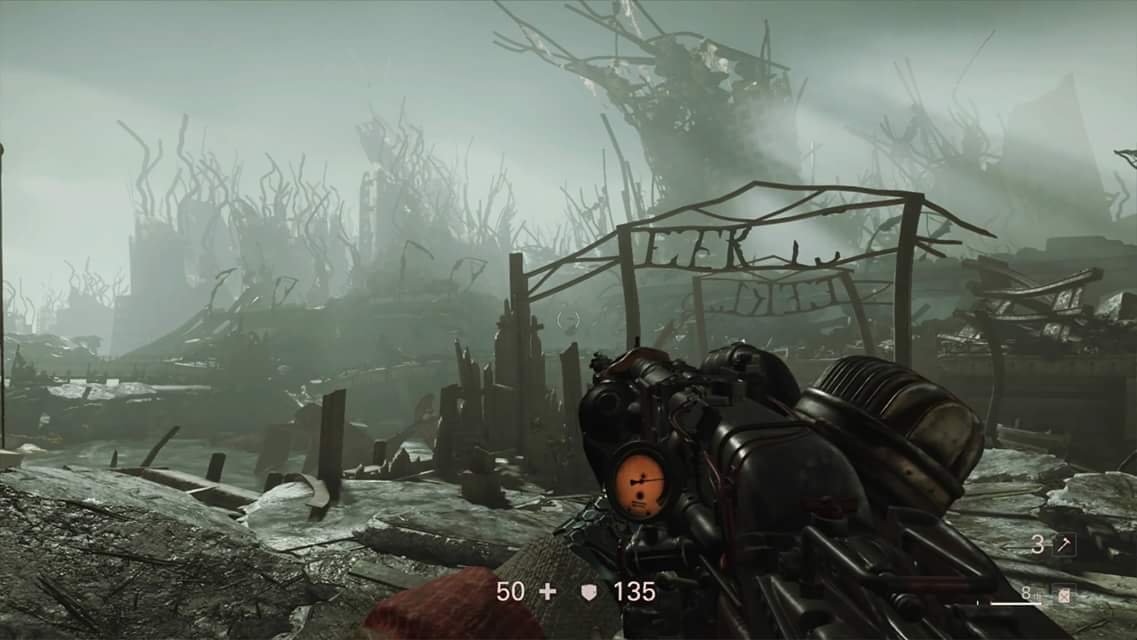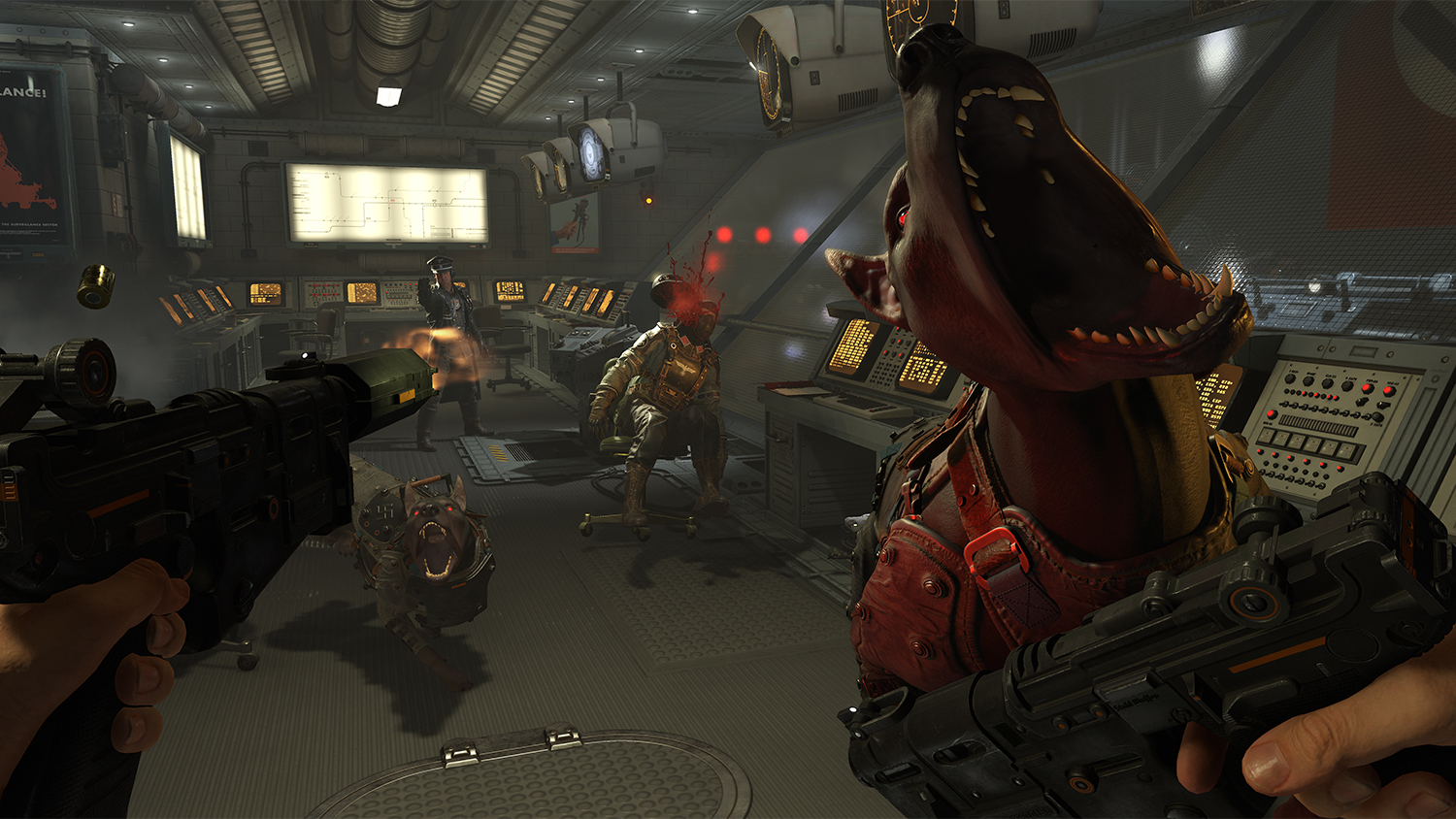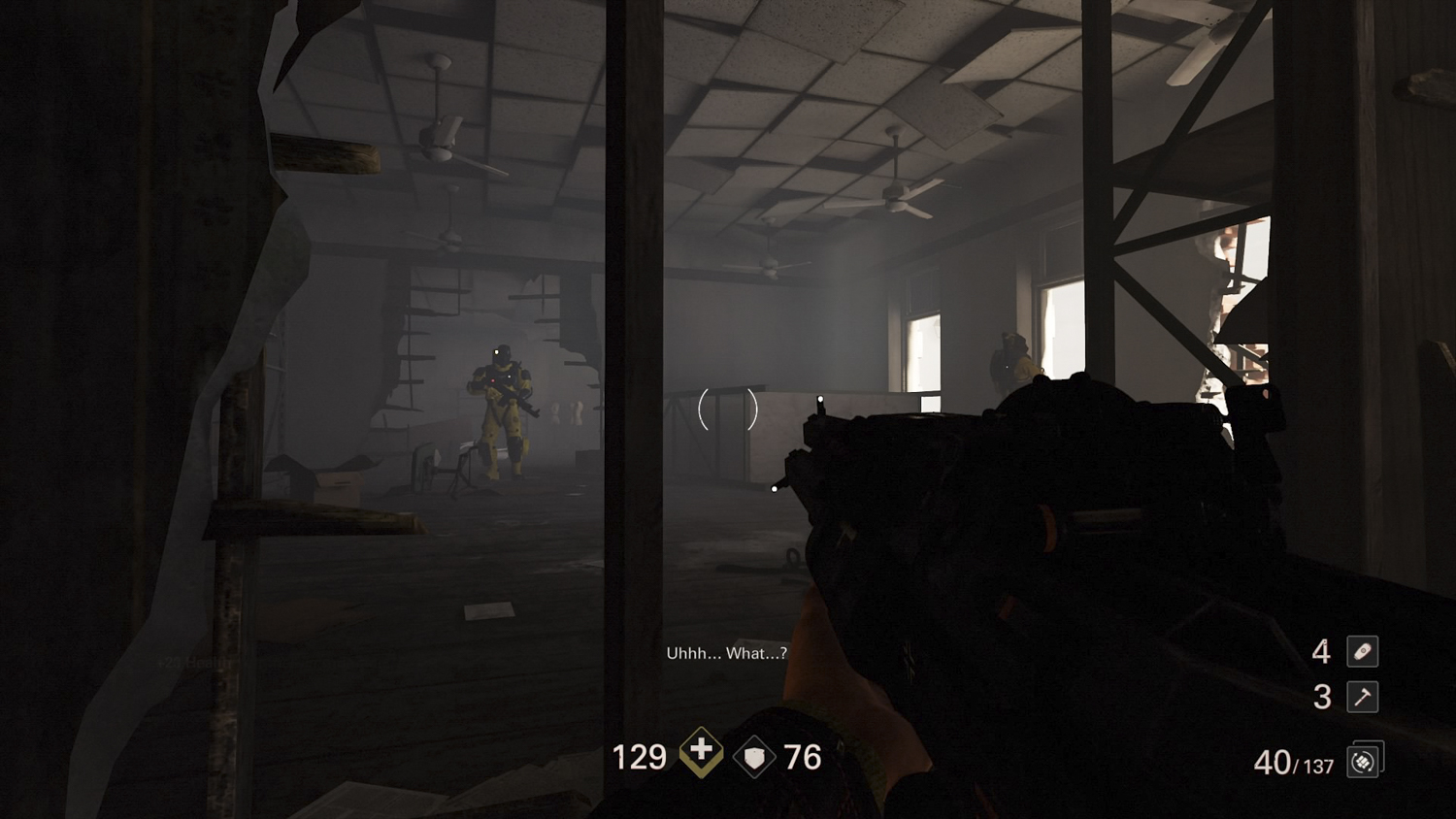“‘Wolfenstein II’ is a delightful narrative shooter that doesn’t quite land its loftiest ambitions.”
- Fun, kinetic shooting action
- Perks create different ways to play
- Rich, but manageable customization
- engaging and human characters
- Silly moments undercut message
- Anticlimactic final encounters
Wolfenstein II: The New Colossus makes sure you know early on that it is not messing around. Somewhere between when the villainous Frau Engel (promoted to General since the first game) mockingly executes a close friend in front of you, and flashbacks to BJ’s abusive, racist, homophobic, anti-semitic father, that the game drives home that Nazis (and the white supremacist ideology that drives them) are the worst. It is a violent game about the downtrodden standing up for themselves against some of humanity’s most brutal and oppressive forces, and it pulls no punches in that regard.
It’s also a game where you infiltrate a secret base on Venus by auditioning to play yourself in a movie about your capture and supposed execution, while old Hitler pees in a bucket. Like its predecessor, Wolfenstein II is both a character-driven war drama and a breezy, over-the-top sci-fi shooter. Chasing that maximalist impulse, the sequel leans harder on both of those elements, and both are better for it, though the seams are more apparent as well.
The New Colossus is perhaps the most ambitious attempt since BioShock Infinite to take a fast, approachable first-person shooter and inject insightful storytelling to create a “kind of meticulously crafted narrative that perpetually rides the line between unfiltered creative excess and intimate character drama,” according to MachineGames creative director Jens Matthies.
Just like Irrational’s 2013 opus, The New Colossus is a joyful and masterfully crafted thrill ride that, on review, doesn’t quite manage to square the levity of its gameplay with the weight of its narrative and thematic ambitions. Regardless, it’s 2017 and the world is in a dark place, so Wolfenstein II: The New Colossus completely succeeds in its primary goal of letting you kill Nazis by the hundreds and have a blast doing it.
Re-revolution
The New Colossus picks up directly where The New Order left off in an alternate version of the 1960s, where the Third Reich won World War II by beating the U.S. to the punch on the atom bomb. Rebel hero B. J. Blazkowicz has defeated General Deathshead and secured the Nazi u-boat Evas Hammer for the insurgent Kreisau Circle, who are off to incite a revolution in the United States.
Wolfenstein II is both a character-driven war drama and a breezy, over-the-top sci-fi shooter.
All of your surviving allies from the first game return, including Anya, Caroline, Bombate, Max Hass, and either Fergus or Wyatt, depending on your choice from the beginning of the first game. (The choice changes cutscenes substantially, and gives you either your trusty Laserkraftwerk or a new, grenade-launching Dieselkraftwerk, encouraging at least one replay). The story charts your escape from Europe through meeting up with American insurgent groups and making key strikes to disable the North American Nazi regime.
While the ‘60s U.S. setting adds a little more color and flair to the outfits of your allies, you’re mostly fighting through genre-standard drab gray military installations and bombed-out urban areas.
Your enemies range from hapless grunts to jacked-up mecha-monsters, mowed down in droves with a variety of mostly standard arms, wielded either alone or in any combination of two. There are moments of invention, but for the most part the game’s aesthetic feels mired in the monotonous, modern military oeuvre, where as a sequel it could have afforded a bit more vibrancy.
Nazis served three ways
The first game’s clever system of tiered perks that organically reinforce your chosen playstyle (such as more stealth takedowns increasing your crouched movement speed) returns, encouraging three distinct playstyles. The three perk trees — Stealth, Tactical, and Mayhem — are simplified from the first game’s four, and explicitly distinguish each style.
Taking out commanders before they can raise an alarm to call reinforcements requires stealth, and that tactical approach benefits this time around from larger and more open levels. If you don’t care about that, however, the game is just as happy to let you either carefully pick apart foes from cover or just YOLO into the fray with guns blazing. The perks work just as well here as before, passively rewarding you for playing however you want while also encouraging you to change up your tactics to chase appealing benefits.
The game is happy to let you carefully pick apart foes from cover or just YOLO into the fray with guns blazing.
The New Colossus leans even harder onto these three modes with the addition of new Contraptions midway through the campaign. Stealthy players get the Constrictor Harness, a girdle that lets you slide under cars or through drain pipes. The Battle Walker, your Tactical option, lets you pop up onto stilts to create your own high ground on the fly. Finally, the Ram Shackles encourage Mayhem, giving you the ability to tackle Nazis and burst through certain walls, Kool-Aid Man-style. You can only choose one at first, although late game sidequests let you unlock the other two.
In addition to those core abilities, the contraptions also come with a suite of secondary effects that further support their given mode. The Harness, for example, gives you a window of slo-mo panic when guards first see you, like in Metal Gear Solid. Like the Fergus/Wyatt timeline choice, the contraptions encourage multiple playthroughs, though we do wish they came earlier in the campaign to allow more time for playful experimentation. Fortunately, bonus missions in previously cleared levels open up late in the game, and they are still available after the credits roll.
Weapon mods are also a new and useful addition, letting you invest kits into three unique upgrades for each gun. Although these don’t quite have the gameplay-altering scope of the mods in Doom, their effects are powerful and immediately felt, adding another layer of playstyle customization to an already rich array of options.
The combat is fast and fun, while offering enough of a challenge that you have to use your tools and your environment deliberately, even at lower difficulties. Several of the late-game battles are a bit of a slog, and the final encounter is particularly underwhelming (such that its finality is only obvious in retrospect). Like BioShock Infinite’s final fight, it’s an open arena battle against waves of big enemies atop an airship that’s more of a grind than it should be.
There are also a few mechanical hiccups —picking up items or chopping open crates feels a bit fiddly, and low-lying environmental features may trip you up. For the most part, though, the action is smooth, engaging, and satisfying, as you would hope from a shooter of its pedigree.
Shooter with a heart of gold
Like BioShock Infinite, Wolfenstein II aspires to elevate the form to be more than just a glorified murder sim, but also a character-driven cinematic experience with something to say. It’s still an astounding feat that they’ve taken B. J. Blazkovicz, the original generic white shooter bro, and made him feel specific and human. The New Colossus delves further into his backstory, finally making canon the original designers’ intent that he is Jewish. He also meditates heavily on his own mortality in monologue throughout the game, which is an uncommonly appropriate theme for the genre.
It’s also more actively inclusive than the first game, with a diverse cast of allies joining B.J.’s side to defiantly show General Engel that real heroes don’t look like any one thing. The opening gameplay moments put the recovering B.J. in a wheelchair as he fends off captors, reinforcing and expanding upon the first game’s pro-disability motif. B.J.’s beloved Anya is pregnant with twins, but kicks more ass than ever.
It’s great to see empowered women in such a male-dominated genre, though there is one pretty egregious moment of topless, blood-spattered excess later in the game that raises question about the developers’ feminist bona fides.
Despite its good intentions, though, the game still feels like it’s told from a fundamentally white, male perspective, and is a little too quick to rely on obvious archetypes for its characters, such as Grace, the foul-mouthed and quick-to-anger, afro-sporting black mother who leads the New York resistance cell. The game never approaches aggressively negative tropes, but benign stereotyping is still stereotyping.
Wolfenstein II struggles acutely and microcosmically with a longstanding hurdle for the industry at large: the desire to be taken seriously paired with a timidity to really get into the mud with messy ideas. Just as BioShock Infinite did, it basically goes no further than saying that racism and fascism are awful. Despite the recent resurgence of open, unmasked white supremacy in American culture, saying that Nazis are bad isn’t a particularly bold or interesting statement in 2017, and the developers deserve neither praise nor scorn for making what was clearly intended to be a relatively apolitical statement.
Our Take
Where Bioshock Infinite struggled to square its kinetic gameplay, fantastical alternate history and half-baked quantum mysticism, Wolfenstein II: The New Colossus sticks the landing better by focusing its scope and context. Nazis were such a staple villain of films and early shooter video games because of the relative moral clarity that World War II afforded.
This is a war game about killing Nazis, and so it’s easier to justify the remorseless mass murder fundamental to shooters than it is in more esoteric settings and stories. Although its moments of wacky, video-game excess don’t always jive with its more dramatic threads, players fell in love with that juxtaposition in the first game, and will be more than willing to forgive a little tonal dissonance in the name of killing Nazis. Wolfenstein II is a generous, self-contained, and lovingly crafted single-player experience, standing proudly defiant of industry trends away from that model.
Is there a better alternative?
Many great first-person shooters have come out in 2017, but no recent games blend gunplay and strong narrative like The New Colossus. The 2013 Wolfenstein reboot and its standalone DLC are still delightful and worth playing before this, but few if any other games match the series’ unique blend of character and gameplay.
How long will it last?
Our first playthrough took roughly 20 hours, with plenty of additional missions and collectibles to find. DLC and another sequel also feel inevitable, given, like in the prior game, the war’s lack of overall resolution at this chapter’s conclusion.
Should you buy it?
Yes. Wolfenstein II a fun, challenging, lushly produced, narrative first-person shooter that any fan of the genre would be remiss to skip.










